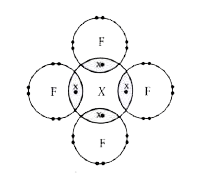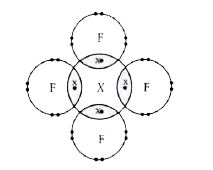Complete Solutions to Exercise (Subjective Problems) (Short Answer Type) of chapter PERIODIC CLASSIFICATION OF ELEMENTS of Class 10 book with complete answers and questions
| Class 10 | CHEMISTRY |
| Chapter | PERIODIC CLASSIFICATION OF ELEMENTS |
| MTG IIT JEE FOUNDATION | Exercise (Subjective Problems) (Short Answer Type) |
| Number Of Questions | 23 |
| Academic Year | 2023-24 |
Three elements 'X', 'Y' and 'Z' have atomic numbers 7, 8 and 9 respectively.
State their position (Group number and period number both) in the Modern Periodic Table.
View SolutionThree elements 'X', 'Y' and 'Z' have atomic numbers 7, 8 and 9 respectively.
Arrange these elements in the decreasing order of their atomic radii.
View SolutionChlorine is an element in period 3 of the Periodic Table. Bromine is found in period 4 of the Periodic Table. These two elements may be from different periods of the periodic table, but they have many similar properties.

Complete the given table
View SolutionChlorine is an element in period 3 of the Periodic Table. Bromine is found in period 4 of the Periodic Table. These two elements may be from different periods of the periodic table, but they have many similar properties.

Explain why the properties of chlorine and bromine closely resemble one another.
View SolutionChlorine is an element in period 3 of the Periodic Table. Bromine is found in period 4 of the Periodic Table. These two elements may be from different periods of the periodic table, but they have many similar properties.

Lithium is an element from Group I of the Periodic Table. Write the formula of the compound formed between lithium and
(i) Chlorine (ii) Bromine (iii) What type of bonding is found in these compounds ? Give reason.
View SolutionWhy atomic size increases on going down the group? Arrange the following in decreasing order of their atomic size -Na, Li, Rb, Cs, K.
View SolutionPotassium bromine and krypton are elements in period 4 of the Periodic Table
In which group of the periodic table can these elements be found ?
(i) Potassium (ii) bromine (iii) krypton
View SolutionPotassium bromine and krypton are elements in period 4 of the Periodic Table
Bromine exists as a molecule. Draw a dot-and-cross' diagram to show the bonding in a molecule of bromine.
View SolutionPotassium bromine and krypton are elements in period 4 of the Periodic Table
Krypton does not react with either potassium or bromine. Explain the unreactive nature of krypton.
View SolutionAn element X has a total of 31 nucleons, out of which 16 are neutrons.
Write the electronic configuration of an atom of element X
View SolutionAn element X has a total of 31 nucleons, out of which 16 are neutrons.
Determine the group and period number of element X.
View SolutionAn element X has a total of 31 nucleons, out of which 16 are neutrons.
Give the formula of the ion formed by element X.
View SolutionWhat physical and chemical properties of elements were used by Mendeleev in creating his periodic table? List two observations which posed a challenge to Mendeleev's periodic law.
View SolutionTable given below shows a part of the periodic table

Using this table explain why
Li and Na are considered as active metals
View SolutionTable given below shows a part of the periodic table

Using this table explain why
Atomic size of Mg is less than that of Na
View SolutionTable given below shows a part of the periodic table

Using this table explain why
Fluorine is more reactive than chlorine?
View SolutionThe given diagram shows the electron arrangement in a compound formed between an element X and fluorine.

What is the formula of this compound?
View SolutionThe given diagram shows the electron arrangement in a compound formed between an element X and fluorine.

Is this an ionic or covalent compound? Give your reason.
View SolutionThe given diagram shows the electron arrangement in a compound formed between an element X and fluorine.

In which group of the periodic table can you find element X?
View SolutionStudy the variation in the atomic radii of first group elements given below and answer the following

Name the elements which have the smallest and the largest atoms
View SolutionStudy the variation in the atomic radii of first group elements given below and answer the following

How does the atomic size vary as you go down a group?
View SolutionAtomic number is considered to be a more appropriate parameter than atomic mass for classification of elements in a periodic table. Why ? How does atomic size of elements vary on moving from:
Give reasons for your answers.
left to right in a period
View SolutionAtomic number is considered to be a more appropriate parameter than atomic mass for classification of elements in a periodic table. Why ? How does atomic size of elements vary on moving from:
Give reasons for your answers.
from top to bottom in a group.
View Solution
Exercise (Subjective Problems) (Short Answer Type) questions and complete solutions for chapter PERIODIC CLASSIFICATION OF ELEMENTS of MTG IIT JEE FOUNDATION of Class 10
All Exercises from MTG IIT JEE FOUNDATION Class 10 CHEMISTRY PERIODIC CLASSIFICATION OF ELEMENTS
- Exercise (Assertion & Reason Type)
- Exercise (Comprehension Type)
- Exercise (Integer/Numerical Value Type)
- Exercise (Match the following)
- Exercise (Multiple Choice Questions Level-1)
- Exercise (Multiple Choice Questions Level-2)
- Exercise (Subjective Problems Very Short Answer Type)
- Exercise (Subjective Problems) (Long Answer Type)
- Exercise (Subjective Problems) (Short Answer Type)
- Illustrations
- NCERT Section
- Olympiad/HOTS Corner
- Solved Examples